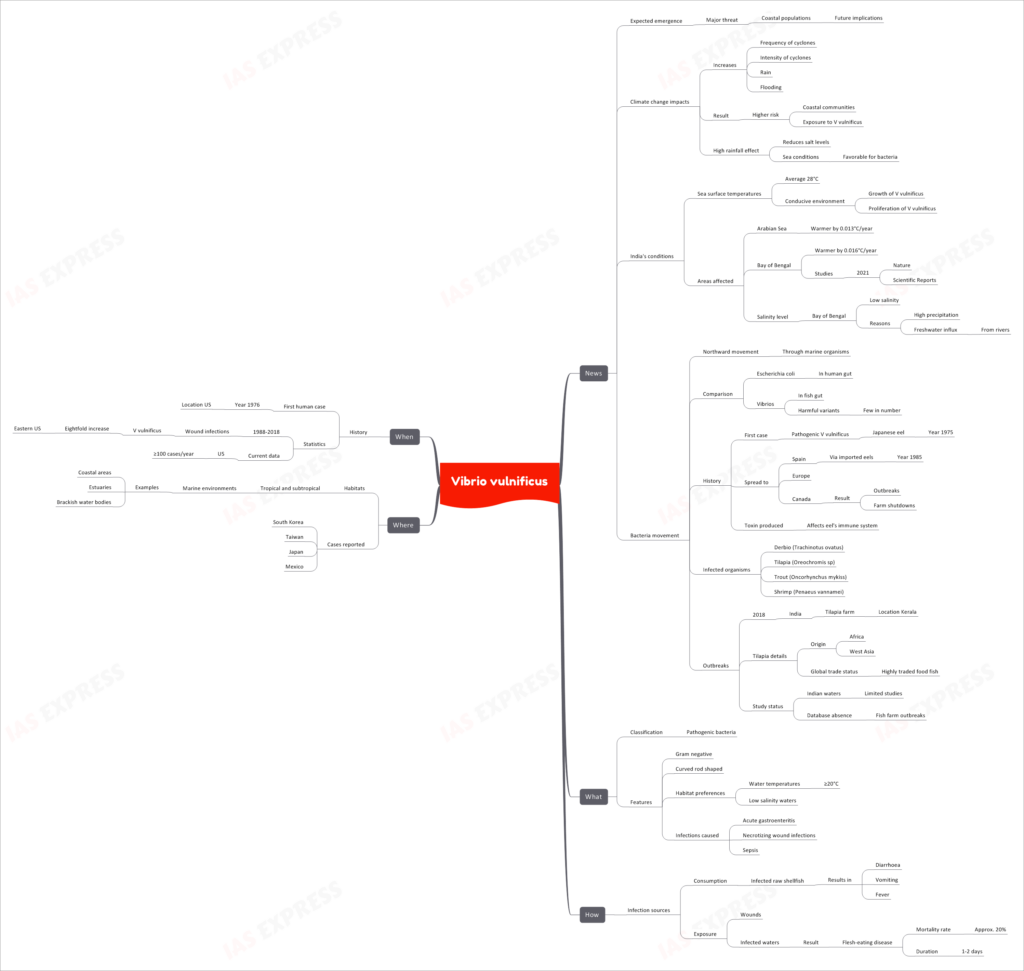Vibrio vulnificus

Recent news highlights the expected emergence of Vibrio vulnificus, a pathogenic bacteria posing a major threat to coastal populations. This article explores the various aspects of V. vulnificus, including its impact on coastal communities, the role of climate change, conditions in India, bacterial movement, classification, features, infection sources, habitats, reported cases, and historical context.
This topic of “Vibrio vulnificus” is important from the perspective of the UPSC IAS Examination, which falls under General Studies Portion.
Expected Emergence: A Major Threat to Coastal Populations
- Coastal Communities at Risk: V. vulnificus poses a significant threat to coastal populations worldwide.
- Future Implications: The emergence of this pathogen could have far-reaching consequences for public health and the environment.
Climate Change Impacts
- Increases in Frequency and Intensity of Cyclones: Climate change has led to a rise in the frequency and intensity of cyclones, affecting coastal regions.
- Increased Rainfall and Flooding: Rising temperatures have resulted in increased rainfall and flooding, further exacerbating the risk.
- Higher Risk for Coastal Communities: The combination of these factors increases the risk of exposure to V. vulnificus.
- High Rainfall Effect: Increased rainfall reduces salt levels in the sea, creating favorable conditions for the bacteria.
India’s Conditions
- Sea Surface Temperatures: India’s sea surface temperatures, averaging 28°C, provide a conducive environment for the growth and proliferation of V. vulnificus.
- Affected Areas: The Arabian Sea and Bay of Bengal are particularly affected, with temperatures warming by 0.013°C/year and 0.016°C/year, respectively.
- Salinity Level in Bay of Bengal: Low salinity levels in the Bay of Bengal are due to high precipitation and freshwater influx from rivers.
Bacteria Movement
- Northward Movement: V. vulnificus can move northward through marine organisms.
- Comparison to Escherichia coli: Unlike Escherichia coli, which is found in the human gut, Vibrios are primarily present in fish gut, with only a few harmful variants.
- Historical Spread: The first documented case of pathogenic V. vulnificus occurred in a Japanese eel in 1975 and subsequently spread to Spain, Europe, and Canada, causing outbreaks and farm shutdowns.
- Toxin Production: V. vulnificus produces toxins that affect the immune system of infected organisms.
Infected Organisms and Outbreaks
- Variety of Hosts: V. vulnificus can infect various organisms, including Derbio, Tilapia, Trout, and Shrimp.
- 2018 Outbreak in India: A significant outbreak occurred in a Tilapia farm in Kerala, India.
- Global Trade Status of Tilapia: Tilapia, originating from Africa and West Asia, is highly traded as a food fish.
- Limited Studies: There is a lack of comprehensive studies on V. vulnificus in Indian waters, and a database on fish farm outbreaks is also absent.
What is Vibrio vulnificus?
Classification
- Pathogenic Bacteria: V. vulnificus is a pathogenic bacterium with harmful effects on humans.
Features
- Gram Negative: This bacterium is classified as Gram-negative.
- Curved Rod Shaped: It has a distinctive curved rod-shaped morphology.
- Habitat Preferences: V. vulnificus thrives in water temperatures of at least 20°C and low salinity waters.
Infections Caused
- Acute Gastroenteritis: V. vulnificus can cause acute gastroenteritis in humans.
- Necrotizing Wound Infections: It is also known for causing necrotizing wound infections.
- Sepsis: In severe cases, V. vulnificus can lead to sepsis.
How Does V. vulnificus Infect?
Infection Sources
- Consumption: Ingesting infected raw shellfish can result in symptoms like diarrhea, vomiting, and fever.
- Exposure: Wounds exposed to infected waters can lead to flesh-eating diseases with a mortality rate of approximately 20%, often lasting 1-2 days.
Where is V. vulnificus Found?
Habitats
- V. vulnificus is commonly found in tropical and subtropical marine environments, including coastal areas, estuaries, and brackish water bodies.
Reported Cases
- Cases of V. vulnificus infections have been reported in South Korea, Taiwan, Japan, Mexico, and the United States.
When Did V. vulnificus First Emerge?
Historical Context
- The first human case of V. vulnificus infection was reported in the United States in 1976.
- Between 1988 and 2018, wound infections caused by V. vulnificus saw an eightfold increase in the eastern United States.
- Current data suggests that the U.S. experiences over 100 cases of V. vulnificus infection each year.
